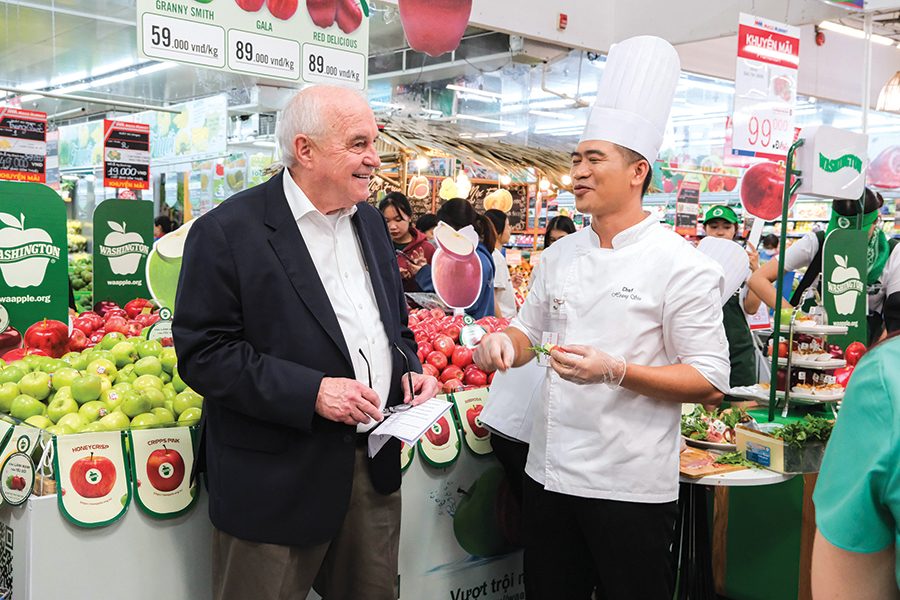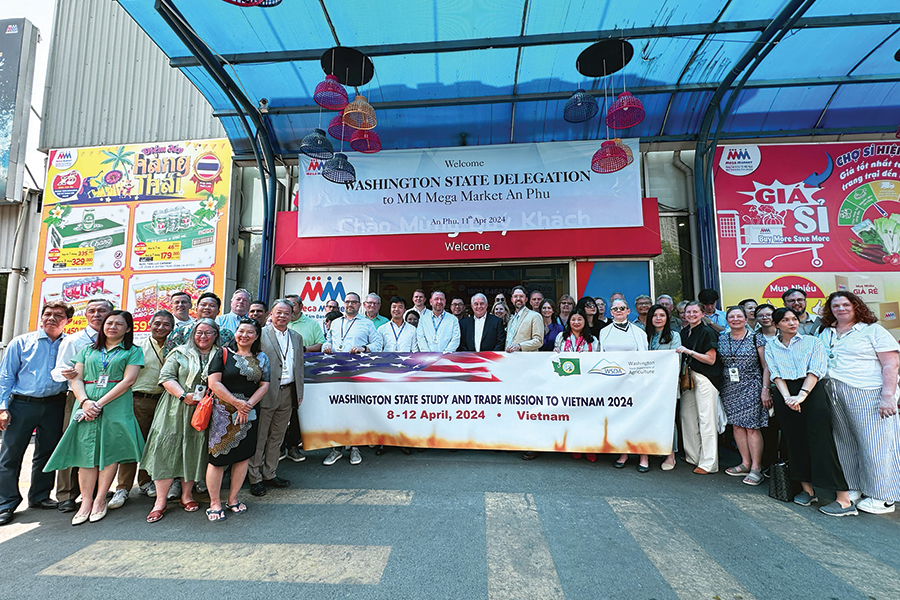
Home » A time to turn challenges into opportunities
A complex landscape
A time to turn challenges into opportunities

Derek Sandison, left, director of Washington State Department of Agriculture, stands in front of a Washington apple promotional display at MM Mega Market in Vietnam.
Courtesy Washington State Department of AgricultureJune 14, 2024
 Derek Sandison,
Washington Department of Agriculture
Derek Sandison,
Washington Department of AgricultureIn early 2023, the U.S. Department of Agriculture’s National Agricultural Statistics Service released the 2022 Census of Agriculture. Washington state’s agricultural industry remains a vital part of our economy, culture and community. However, the data reveals a complex landscape where our producers face unprecedented challenges and confirms what industry experts have been expressing for years.
Leading the way
Washington’s diverse agricultural output continues to impress. We are a leading producer of a wide variety of crops, including apples, cherries, hops and wine grapes. Our dairy, livestock and aquaculture sectors are also robust.
The 2022 Census highlights some notable achievements:
- Washington remains the top apple producer in the nation, contributing more than 60% of the total U.S. apple production.
- Though our cherry harvest fluctuates year to year based on a gambit of changing variables, overall, our cherry production has seen a significant increase, reaffirming our status as a premier cherry producer.
- The state’s wine industry continues to flourish with Washington ranking as the second-largest wine producer in the country.
However, these successes are not without shadows. The census data also reveals several areas of concern that warrant closer attention.
Farms: then and now
In 2017, at the time of the last agricultural census, Washington counted nearly 35,800 farms covering 14.7 million acres. According to the 2022 census, we now have 32,076 farms spread across 13.9 million acres of agriculturally dedicated land. That’s a loss of roughly 3,700 farms and 1 million acres.
In terms of cropland, the numbers paint a less daunting picture. Washington lost only 100,000 acres – 7.5 million to 7.4 million – of cropland (anything non-livestock or shellfish related) suggesting that cropland acreage is relatively stable.
A reduction in farm numbers was seen across nearly every category of farm size except for those between 500 acres and 999 acres, due likely to consolidation. Some of that consolidation was seen in some of our largest farms with a corresponding shift from local ownership to out-of-state ownership. This is a cause of concern for our agricultural-based rural communities.
Rising input costs
One of the most pressing issues, and a challenge widely felt by our producers, is the dramatic increase in input costs. From fuel and fertilizers to labor and farm equipment, the costs of running an agricultural operation have surged. This is driven by a combination of supply chain disruptions, inflation and geopolitical tensions. For instance, the price of fertilizer has nearly doubled in some cases, directly impacting our farmers’ bottom line.
Energy costs are another significant burden. The volatility in fuel prices not only affects the direct costs of running machinery but also influences transportation costs.
Labor issues
Labor shortages continue to be an industry-wide issue. As we noted in 2023, continued increases in farm labor costs, coupled with overtime requirements – which come into play at the 40-hour threshold – have made an already difficult situation more serious.
In practice, this has often meant that producers must either reduce hours for those working or employ fewer people to balance the overtime requirements with what is financially feasible for their operation.
Drought forecast
It’s too early to say with certainty how severe this year’s forecasted drought will be or how it will affect crop yields, but we are already seeing adverse impacts to irrigated agriculture in the Yakima Valley. The state Department of Ecology’s drought declaration in April underscores the need for building drought resilience into water management systems across the state.
In addition, the prolonged cold spell that occurred last winter inflicted crop damage and will likely result in a reduction in yields of cherries and wine grapes in some areas. The extent of that damage is still being assessed.
Supply chain, food security
We witnessed the vulnerability of our supply chain through the disruptions caused by the pandemic, including high freight rates, lack of vessel space, container shortages and congestion. Even though these disruptions have largely normalized, we expect additional impacts to come from outside Washington’s borders, affecting the bottom line for many of our producers whose commodities are exported overseas.
For example, shipping disruptions in the Suez and Panama canals have resulted in substantial delays and equipment availability issues. While not significantly affecting Washington shippers, those disruptions demonstrate how events beyond our control can impact the movement of goods around the world.
In addition, there is a growing need to recognize the possibility of intentional disruptions to our supply chain, and in particular, our food supply. In April, the Washington State Department of Agriculture, or WSDA, partnered with the FBI to hold an Agricultural Threats Symposium aimed at highlighting the vulnerabilities within our agricultural and food processing systems and identifying solutions to address those weaknesses.
Trade disruptions
Washington food and ag exports were down about 6% in 2023 compared to the prior year, primarily due to worldwide economic challenges, inflation and the strong U.S. dollar. We hope to see some improvement this year, although economic dynamics remain uncertain.
Despite trade disruptions caused by retaliatory tariffs since 2018, China remains Washington’s No. 3 agricultural market. However, the “trade war” with China appears to be ramping up again, and we may see increased or additional retaliatory tariffs on agricultural products coming this year.
We continue to diversify and invest in relationships with other promising markets. This is demonstrated through our recent trade missions to Vietnam and the signing of a memorandum of understanding, or MOU, between the state of Washington and Vietnam’s Ministry of Agriculture and Rural Development.

The Washington state delegation stands outside MM Mega Market in Vietnam during a recent trade mission.
| Courtesy Washington State Department of AgricultureThe MOU will put in motion a variety of actions and objectives such as coordinating trade promotion activities, supporting supply chain development, growing academic and research ties through collaborative projects, and facilitating information sharing and best practices for agricultural research and technology between appropriate institutions in Washington state and Vietnam.
On a positive note, India’s removal of retaliatory tariffs on U.S. apples last year has benefited Washington’s apple industry. Although competitors such as Turkey have largely taken our market share, we look forward to seeing exports of Washington apples to India continue to grow this year and beyond.
Invasive pests
Trapping and eradicating invasive pests is an ongoing effort, and while we have productive mechanisms in place to locate and remove them, we cannot anticipate what each trapping season will bring.
I’m pleased to share that the Legislature approved our agency-request legislation as well as $1 million in ongoing annual funding for a dedicated Agricultural Pests and Disease Response Account that will aid WSDA’s future response efforts.
Invasive spongy moth and Popillia japonica (Japanese beetle) eradication packages also were allocated one-time funding to continue efforts already in place.
Ag viability conference
Between fluctuating product prices, high input costs, little to no expansion of foreign markets, and constant interference of weather and pests, maintaining economic viability is a struggle for many of Washington’s farmers and ranchers. This should be of concern to all Washingtonians and highlights the need to better document what is driving current economic conditions.
In May 2024, WSDA partnered with the Washington State University College of Agricultural, Human, and Natural Resources Sciences to host the Washington State Agricultural Viability Conference in Kennewick.
The event brought together stakeholders, industry leaders and policymakers to discuss the future of Washington agriculture. Producers from around the state and across various sectors of the industry were encouraged to share the challenges facing their operations with the intent that together, we could identify possible solutions.
Discussions and data shared at the conference will help inform the Agricultural Competitiveness Study, conducted by WSU IMPACT Center, on the viability and overall competitiveness of Washington agriculture. The Legislature awarded WSDA funding for the study in 2023. Upon completion, findings will be shared with the Legislature, our congressional delegation and the public, and will be used to identify measures that can be taken to level the playing field for our farmers and ranchers.
By addressing the immediate challenges and investing in long-term solutions, we can help ensure that our state’s agricultural industry remains strong and resilient. Together, we can turn challenges into opportunities and continue to lead the nation in agricultural excellence.
Derek Sandison is the director of the Washington State Department of Agriculture.
Focus Magazine Agriculture + Viticulture
KEYWORDS June 2024
Related Articles




